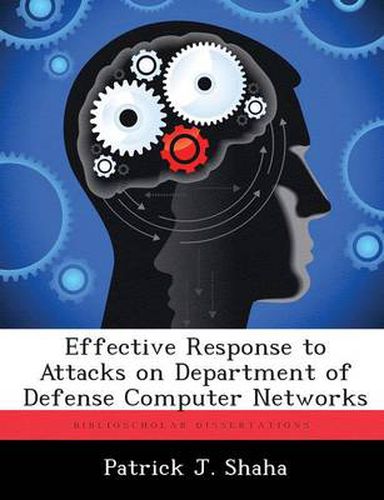Readings Newsletter
Become a Readings Member to make your shopping experience even easier.
Sign in or sign up for free!
You’re not far away from qualifying for FREE standard shipping within Australia
You’ve qualified for FREE standard shipping within Australia
The cart is loading…






This title is printed to order. This book may have been self-published. If so, we cannot guarantee the quality of the content. In the main most books will have gone through the editing process however some may not. We therefore suggest that you be aware of this before ordering this book. If in doubt check either the author or publisher’s details as we are unable to accept any returns unless they are faulty. Please contact us if you have any questions.
The proliferation of information technology within Department of Defense (DoD) has markedly improved the speed and reach of command and control capabilities. The ease of entry and global availability of network access makes automation linked through networks an optimal medium for sharing information. For the Commanders-in-Chief (CINCs), computer networking has proven especially useful in maintaining contact and sharing data with elements forward deployed as well as with host nation governments and agencies. The significant improvements have come, however, at a high cost in security. Internet access is, by design, wide open to all public networks and to all users, regardless of nationality, language, or intent (criminal or otherwise). Though protection measures are somewhat more robust than in the recent past, virtually any network user is capable of causing serious damage to systems connected to the Internet, as well as trigger isolated collapse of the network itself. The ability to selectively share and deny access to sensitive information with multiple network users has proven a daunting challenge To date there is no central authoritative body empowered to direct Internet structure or enforce rules of operation. Rather, the very lack of regulation and oversight is seen as the real strength and power of the Internet. Within the regimented world of the DoD there has been in the past little cooperative agreement on how to handle network standardization and upgrade issues, particularly when the warfighting CINCs attempt to use their Title X authority to enhance interoperability among their subordinate service components. Is there relevance for a CINC and his theater to properly respond to a Computer Network Defense (CND) event without an accompanying global response? Does the current chain-of-command for such a response provide the speed and capabilities to assure the security of DoD networks? The current status of CND efforts within DoD supports the conclusion that
$9.00 standard shipping within Australia
FREE standard shipping within Australia for orders over $100.00
Express & International shipping calculated at checkout
This title is printed to order. This book may have been self-published. If so, we cannot guarantee the quality of the content. In the main most books will have gone through the editing process however some may not. We therefore suggest that you be aware of this before ordering this book. If in doubt check either the author or publisher’s details as we are unable to accept any returns unless they are faulty. Please contact us if you have any questions.
The proliferation of information technology within Department of Defense (DoD) has markedly improved the speed and reach of command and control capabilities. The ease of entry and global availability of network access makes automation linked through networks an optimal medium for sharing information. For the Commanders-in-Chief (CINCs), computer networking has proven especially useful in maintaining contact and sharing data with elements forward deployed as well as with host nation governments and agencies. The significant improvements have come, however, at a high cost in security. Internet access is, by design, wide open to all public networks and to all users, regardless of nationality, language, or intent (criminal or otherwise). Though protection measures are somewhat more robust than in the recent past, virtually any network user is capable of causing serious damage to systems connected to the Internet, as well as trigger isolated collapse of the network itself. The ability to selectively share and deny access to sensitive information with multiple network users has proven a daunting challenge To date there is no central authoritative body empowered to direct Internet structure or enforce rules of operation. Rather, the very lack of regulation and oversight is seen as the real strength and power of the Internet. Within the regimented world of the DoD there has been in the past little cooperative agreement on how to handle network standardization and upgrade issues, particularly when the warfighting CINCs attempt to use their Title X authority to enhance interoperability among their subordinate service components. Is there relevance for a CINC and his theater to properly respond to a Computer Network Defense (CND) event without an accompanying global response? Does the current chain-of-command for such a response provide the speed and capabilities to assure the security of DoD networks? The current status of CND efforts within DoD supports the conclusion that